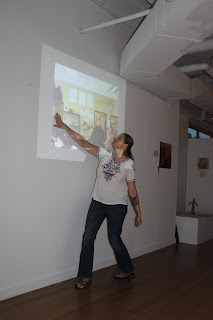The events described in this post took place during one class setting on April 24th, 2014.

Eight year old Frank is helping five of his classmates select materials for a large floor sculpture. “Dude! We added new designs to it. Look we got things like new support beams!” John watches the action, “How are you making this thing? Can I help you?” Frank replies, “You could, you could put something down here on it.” Working with wooden blocks, chairs and benches, Frank and his crew of 2nd grade classmates are in the course of building a 15 foot long re-creation of the Tacoma Narrows Bridge. Their teacher has been observing from a distance and moves in to converse with the builders, “Aren’t you concerned about the safety of your bridge?” The boys respond, “It’s safe! It’s safe! It’s not that bad, you’ll only fall two thousand feet!” The historian of the group, eight year old Ken provides insight, “The Tacoma Narrows Bridge collapsed when it was 4 months old. It sadly collapsed while a poor dog was trapped inside a car. He later fell at the bridge. He did not make it out alive.”

Ken’s teacher is fascinated, “What a tragedy! What inspired you to build this bridge?” Ken explains, “This is the ‘new’ Tacoma Narrows Bridge. The old Tacoma Narrows bridge video is on the Internet. So we watched the video and we got inspired by it so we built this one.” Ken’s team, an energetic group of boys, continue to stack and weave new parts into the structure and have transformed ordinary stools into bridge columns. The teacher congratulates the boys on their attempt at initiating such a large project and documents their sculpture progress with digital photographs. He moves on to observe and interact with other students.

Evidence of unique developmental rhythms and the personal nature of art making are all around Frank, Ken and John’s classroom. Moving about freely, other classmates have set up their own work spaces, communicate easily with each other and busy themselves with a variety of materials, tools and art making techniques. Two girls are painting landscape pictures, another girl works on a giraffe illustration while a boy concentrates on a dragon drawing with pencils, oil pastels and paints. Another student knots yarn to create a bracelet while her best friend is working on what appears to be a non-objective painting with green and blue tempera paint. The teacher notes there are painters, sculptors, weavers and other artists working in the room. He documents their activities with a digital camera.

The children exhibit a natural capacity for creative actvity. The teacher believes there can only be one reason for the artistic behavior he is observing. Art making is an inborn endowment. Heterogeneous groups of children are able to develop a myriad of intellectual, social and emotional skills through self-directed art making. In this setting devoted to child centered learning experience, students discover emancipatory knowledge of the self. These learning activities address real developmental needs and are not token responses but woven into the curriculum throughout the duration of the child’s experience in the art room.

The girl working on the green and blue non-objective painting begins to add packing tape to her wet painting. She informs her teacher she is engaged in an experiment to develop art with a shiny surface. After completing her experiment, she writes in her journal, “ Art is a part of being creative your always doing art. When your [sic] creative, your [sic] doing better than you are when your not.”
This artist statement reveals the efficacy of choice based art education settings to address neuropsychological domains of intelligence in children. Engaged in meta-cognition, the girl reveals how beneficial her art making processes are to her well being. That is a critical distinction here. They are her processes and her teacher is pro-actively facilitating her creative autonomy. Student autonomy is essential in order to fully address children's specific developmental pathways.

No where to my knowledge is this immensely important fact, that child development is inextricably linked to academic achievement, taken into account in mainstream education policy circles hell-bent on maintaining a broken system centered upon the intensification of high stakes standardized testing. Nan Hathaway and Diane Jaquith ask the question in their essay, "Where's the Revolution?" The revolution is happening now and it is being led by teachers who understand mind, body and spirit are all connected. These teachers are preparing learning environments and adjusting pedagogy to address developmental needs of children not addressed through traditional subject centered experience that focuses primarily on acquisition of technical knowledge.
Classrooms centered exclusively upon authoritarian forms of learning experience marginalize the possibility of children's opportunities for self-determination as a means of acquiring emancipatory knowledge of the self. This is problematic. There is significant mental health data to suggest that educational experience concerned primarily with predictability and efficiency, lacks efficacy in providing natural pathways for the unique in-born endowment, talents and genius of children to unfold.
Comer, J.P. (2005). Child and adolescent development: The critical missing focus in school reform. Phi Delta Kappan, 86 (10)
Hathaway, N., Jaquith, D. (2014) Where's the Revolution? Phi Delta Kappan, vol 95, no. 6, 25-29
.









































